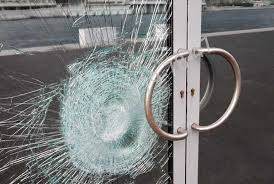Hardening is a common way to protect the glass. Tempered glass is stronger than annealed 4-6
times thanks to creating compressive stress inside the glass. Upon impact (car
accident, broken door or architectural panel), the tempered glass breaks down
into small obtuse-angled fragments, resembling more crushed corn than glass,
and not causing serious injuries. Due to this property of tempered glass, the
term "safety glass" appeared. Tempered glass also has increased
strength and heat resistance.
 |
| Armoring Film |
A very practical
way to strengthen and protect finished glass structures (such as windows of houses
and cars, screens of phones and tablets) is to stick on them various polymer
films with a thickness of about 0.1-2.0 mm. Protective films are hard enough to
withstand scratches, and elastic enough and sticky so as not to crack when
glass breaks under impact. The strength of thick “armoring” films for windows
and showcases, with proper fastening to the frame, allows the glass to even
withstand some time while they try to knock out the window with a metal tool. Currently,
there are already films that give bulletproof glass.
 |
| Reinforced Glass |
For the glazing of doors and openings inside
administrative, residential and industrial buildings, reinforced glass is used.
It is a glass, supplied inside with the so-called reinforcing metal wire in the
form of a grid. It may seem that the presence of metal mesh makes the glass
stronger, but it is not. Reinforcement, contrary to popular belief, weakens the
glass, making it more fragile compared to the same monolithic glass. Reinforced
glass has a trauma protection function: in case of breaking the glass, pieces
are hung on the reinforcing wire. Along the way, reinforcing wire serves for
decorative purposes.
Related Posts